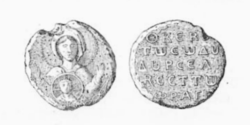Battle of the Zompos Bridge
| Battle of Zombos Bridge | |||||||
|---|---|---|---|---|---|---|---|
| Part of the Byzantine-Norman Wars | |||||||
 Seal of the rebellious Italo-Norman mercenary, Roussel de Bailleul | |||||||
| |||||||
| Belligerents | |||||||
| Rebellious Norman mercenaries | Byzantine Empire | ||||||
| Commanders and leaders | |||||||
| Roussel de Bailleul |
John Doukas Andronikos Doukas Nikephoros Botaneiates | ||||||
| Strength | |||||||
| 3,000 soldiers, most of whom were knights |
12,000 soldiers including:
| ||||||
| Casualties and losses | |||||||
| few | Many were casualties and prisoners of war, including John Doukas and Andronikos Doukas | ||||||
The Battle of the Zombos Bridge or Zompos Bridge was fought between the Byzantine Empire and a group of rebellious Norman mercenaries under their Italo-Norman leader, Roussel de Bailleul in the year of 1073.[1], near a bridge on the banks of the Sangarios River. The bridge in the Phrygia region of Anatolia, near Amorium, the capital of the Anatolic Theme. The decisive defeat of the Byzantine army would further undermine Byzantine authority in Anatolia and Armenia,[2] especially as the defeat came after the shattering defeat by the emerging Seljuk Turks at the Battle of Manzikert. The defeat would allow a power vacuum in Asia Minor, one which the Turks would exploit, with Suleiman ibn Qutalmish, leading a band of Seljuk Turks, conquering vast swathes of the Central Anatolia region, especially its Central Anatolian steppe which was now vulnerable due to the crushing defeat of the Byzantines and allowed for the gradual Turkification of Anatolia.
Prelude
[edit]Following the establishment of the Duchy of Normandy, the Normans quickly assimilated to the local French culture, speaking the French language, intermixing with the French, becoming Christian, establishing feudalism, and becoming professional French knights. With such a small territory, but having a growing population, the many lords of the duchy often fought with each other for control of more fiefs, increasing the military experience of the Normans. Before long, due to the growing population, there were more lords than there were land to conquer. This caused many Normans to leave the small duchy to many foreign lands, seeking loot, land, and glory in the new places. This caused many Normans to setoff for Southern Italy. Taking advantage of the disunity of the region, these hardy Franco-Norsemen, with their martial prowess, conquered many lands, loot, and glory from the many peoples of it, like the Lombards of Benevento, Salerno, and Capua, the Byzantine Catepanate of Italy, and the Kalbids, a dynasty of Muslim Sicily. One of these Normans was a man named Roussel de Bailleul.
Roussel de Bailleul (died 1077), also known as Phrangopoulos (Greek: Φραγγόπουλος, lit. 'son-of-a-Frank') and Norman Chief Roussel (lit.Turkish: Norman Reisi Ursel), or in the anglicized form Russell Balliol was a Norman adventurer He is also known by the Eastern Romans as Ursellus de Ballione in Latin or Roscelin or Roskelin de Baieul, and Anna Comnena called him Ourselios (Οὐρσέλιος), also rendered Urselius.
Roussel ventured with the Apulian Normans to Italy, settled in Terra d'Otranto and served under Roger de Hauteville in Sicily. During the Conquest of Sicily, according to Geoffrey Malaterra, Roussel distinguished himself with his bravery at the Battle of Cerami, where he urged Count Roger to pursue the fleeing Saracens. Aside from this brief account by Malaterra, the Alexiad of Anna Comnena is the main source for Roussel. Following Roussel's glorious achievements in Sicily and Southern Italy, the Norman adventurer, either in search of more glory and plunder or in exile, came to the Byzantine Empire where he became a mercenary for the Byzantine army.
Battle
[edit]Aftermath
[edit]References
[edit]- ^ Beihammer 2017, pp. 210.
- ^ Holt, Peter Malcolm; Lambton, Ann Katharine Swynford; Lewis, Bernard (1977). The Cambridge History of Islam. pp. 231–232.
Sources
[edit]- Beihammer, Alexander Daniel (2017). Byzantium and the Emergence of Muslim-Turkish Anatolia, Ca. 1040-1130. Taylor & Francis. ISBN 978-1351983860.
